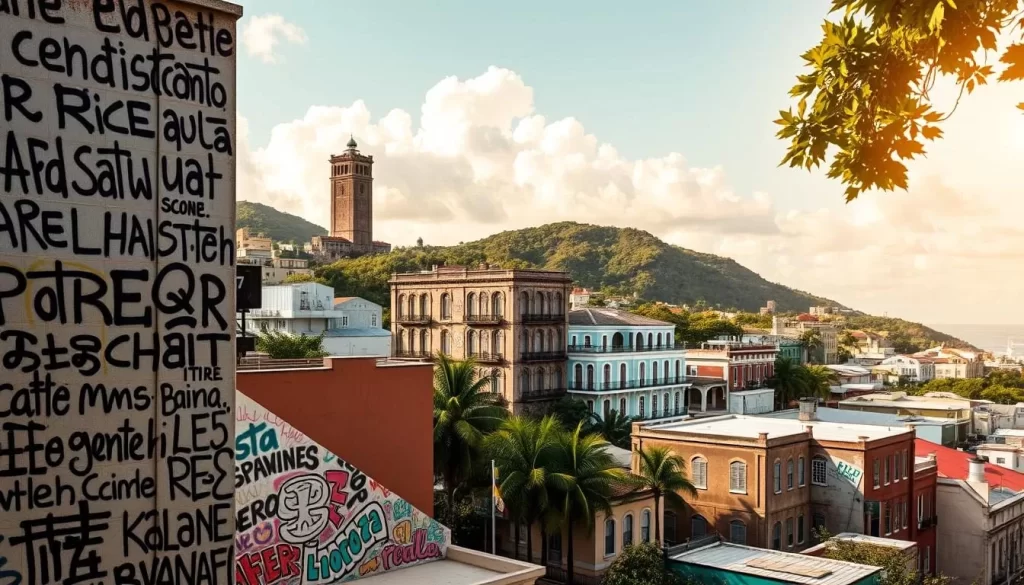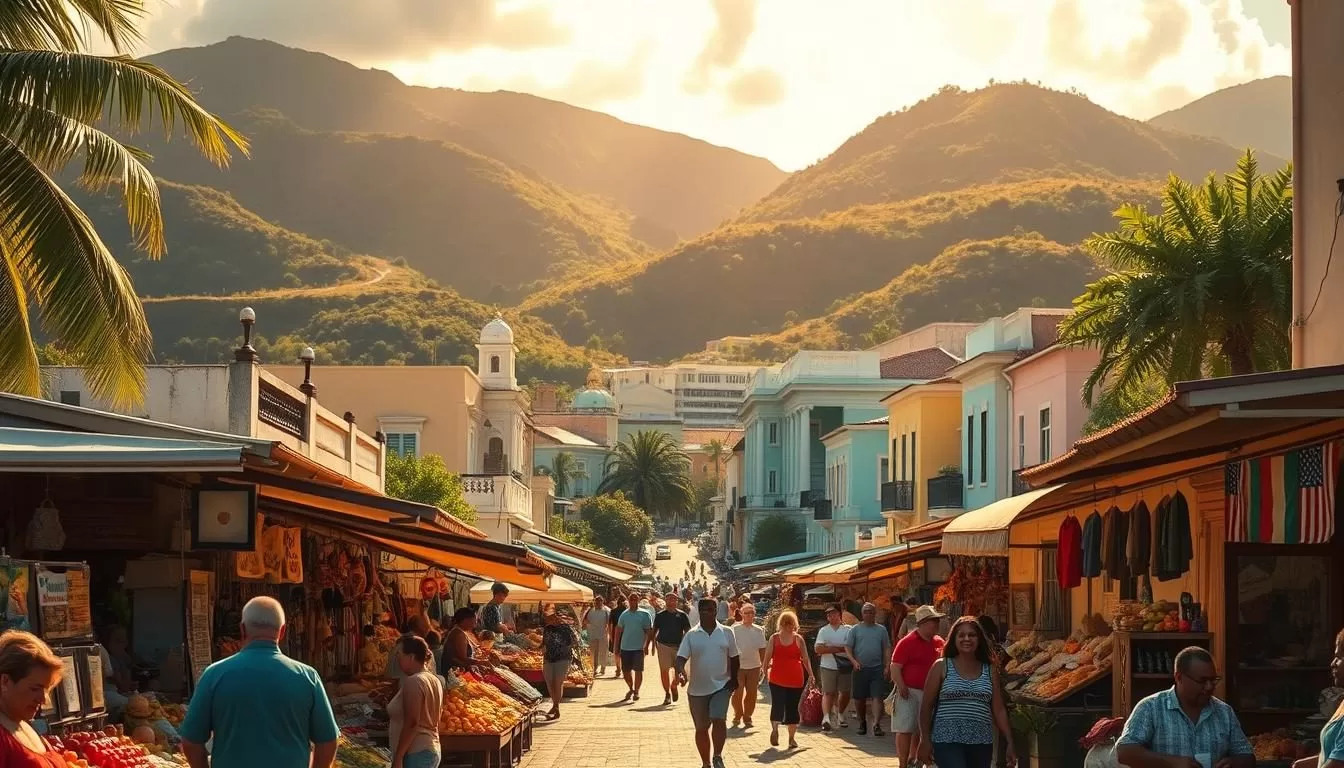✓ Accommodations✓ Flights✓ Rental Cars
Nestled in the Caribbean, the U.S. Virgin Islands are a tropical paradise with a rich cultural heritage. This territory, consisting of St. Thomas, St. John, and St. Croix, has a fascinating history shaped by Danish rule before becoming part of the United States in 1917. Today, it’s a vibrant destination known for its stunning beaches, warm climate, and diverse population.
English is the primary language spoken here, reflecting its status as a U.S. territory. However, the islands also embrace linguistic diversity, with Spanish and French Creole being spoken by significant portions of the population. This blend of languages adds to the unique charm of the region, making it a fascinating place for visitors to explore.
Whether you’re strolling through the historic streets of Charlotte Amalie or soaking up the sun on pristine beaches, the islands offer a mix of history, culture, and natural beauty. Understanding the local language and cultural nuances can enrich your experience and help you connect with the warm and welcoming people of this tropical haven.
Overview of the U.S. Virgin Islands
Located in the heart of the Caribbean, the islands of St. Croix, St. John, and St. Thomas offer a unique blend of natural beauty and cultural richness. Situated in the Lesser Antilles, they are just east of Puerto Rico, making them a convenient destination for travelers. The tropical climate, with average temperatures ranging from 77°F to 82°F, ensures year-round warmth and sunshine.

Geography and Demographics
The islands are part of the West Indies and are known for their volcanic origins, white sand beaches, and vibrant coral reefs. St. John, for instance, is home to the Virgin Islands National Park, which covers two-thirds of the island. The population of approximately 105,870 is diverse, with 75% identifying as Black and 25% of European, Asian, and Latin descent.
Each island has its own character. St. Croix is the largest, with a population of around 56,200, while St. Thomas is the most populous at 54,000. St. John, with just 4,400 residents, is the smallest but offers a tranquil escape. The capital, Charlotte Amalie, is a bustling hub on St. Thomas, rich in history and culture.
Cultural and Economic Background
The islands have a fascinating history shaped by Danish rule and the abolition of slavery in 1848. After becoming a U.S. territory in 1917, the economy transitioned from plantation-centered to tourism-driven. Today, tourism is the primary economic driver, attracting visitors with its pristine beaches, duty-free shopping, and vibrant culture.
The cultural heritage is a blend of African, European, and Caribbean influences, reflected in the local dialects and traditions. This diversity has created a unique backdrop for the language spoken today, making the islands a fascinating destination for those interested in history and culture.
Historical Linguistic Influences
The linguistic history of the islands reflects a blend of colonial and cultural influences. Over the years, the region has seen a fascinating evolution in its spoken languages, shaped by centuries of foreign rule and local adaptation.

Danish and Dutch Colonial Impacts
During Danish rule, Danish was the official language, though it was rarely spoken by the general populace. Instead, a Dutch Creole known as Negerhollands emerged among slaves and planters. This creole became a common form of communication, blending Dutch with African and Caribbean elements.
The Dutch influence was significant, especially in the early years of settlement. However, as the islands transitioned to U.S. control in 1917, English began to dominate. This marked a turning point in the linguistic landscape.
The Transition from Colonial Tongues to Modern Usage
The 1917 transfer treaty was a pivotal moment in the islands’ history. It not only changed political control but also accelerated the shift in language preference. English gradually replaced Danish and Dutch Creole as the primary language.
Historical events, such as plantation economics and slave rebellions, played a crucial role in shaping language usage. Over time, modern English and creole variants became the norm, reflecting the islands’ evolving identity.
| Period | Dominant Language | Key Influences |
|---|---|---|
| Danish Rule | Danish (official), Negerhollands (spoken) | Dutch Creole, African dialects |
| Post-1917 | English | U.S. influence, creole evolution |
Today, the islands’ linguistic heritage is a testament to their rich history. From colonial tongues to modern dialects, the journey of language here is as diverse as the people who call this place home.
U.S. Virgin Islands, United States: Official and widely spoken languages
English dominates as the primary language, but the islands’ linguistic heritage tells a deeper story. As the official language, it’s used in government, education, and daily life. This reflects the territory’s status and its connection to the broader world.
Historical remnants of Danish rule are still visible today. Street names and some local vocabulary bear traces of this colonial past. While Danish is no longer spoken, its influence adds a unique layer to the islands’ identity.

Immigration and tourism have further shaped the linguistic landscape. Spanish and French Creole are widely spoken, especially in informal settings. According to recent census data, 74.7% of the population speaks English, while 25.3% use other languages.
“The blend of languages here reflects the islands’ rich cultural tapestry.”
Understanding the linguistic diversity is vital for visitors and residents alike. It helps bridge cultural gaps and fosters deeper connections with the local community. Whether you’re exploring St. Thomas or relaxing on St. Croix, knowing the language landscape enhances your experience.
Modern Linguistic Diversity and Usage
Today, the islands showcase a fascinating blend of languages shaped by history and migration. English remains the dominant language, used in government, education, and daily life. However, the linguistic landscape is far from monolithic, with regional variants and other languages adding depth to the cultural fabric.

The Prevalence of English and Its Variants
English is the primary language, spoken by approximately 74.7% of the population. Its dominance reflects the islands’ status as a U.S. territory. However, local dialects like Virgin Islands English Creole add unique flavors to the language. These variants feature distinct pronunciation and vocabulary, differing slightly across St. Thomas, St. John, and St. Croix.
In casual settings, you’ll notice the influence of African and Caribbean elements in the local English. This blend creates a dynamic linguistic environment, where tradition meets modernity.
The Roles of Spanish and French Creole
Spanish is the second most spoken language, used by about 16.8% of the population. Its prevalence is largely due to migration from Puerto Rico and the Dominican Republic. In communities like St. Thomas, Spanish is often heard in informal conversations and local businesses.
French Creole, spoken by 6.6% of residents, is another important language. Brought by immigrants from islands like St. Barthelemy and St. Martin, it holds cultural significance. This creole is a reminder of the islands’ historical ties to the broader Caribbean region.
| Language | Percentage of Speakers | Key Influences |
|---|---|---|
| English | 74.7% | U.S. influence, local creole |
| Spanish | 16.8% | Migration from Puerto Rico, Dominican Republic |
| French Creole | 6.6% | Immigrants from St. Barthelemy, St. Martin |
This linguistic diversity enriches the islands’ cultural tapestry, making it a unique destination for visitors and a vibrant home for residents.
Cultural Impact on Language Development
The cultural melting pot of the Caribbean has left a lasting imprint on the language spoken in the islands. Over centuries, the blending of African, European, and Caribbean influences has shaped a unique linguistic identity. This diversity is most evident in the development of Virgin Islands Creole English, a dialect that reflects the islands’ rich history and multicultural heritage.
The Emergence of Virgin Islands Creole English
The roots of this creole trace back to the plantation era, where enslaved people created a simplified language to bridge communication gaps. Influences from English, Dutch Creole, and African dialects blended to form a distinct linguistic system. Over time, this creole evolved, incorporating elements from other languages spoken by immigrants and settlers.
Today, Virgin Islands Creole English is characterized by its unique grammar and vocabulary. For example, verb conjugations often differ from standard English, and certain words have entirely new meanings. This creole is not just a language but a testament to the resilience and creativity of the islands’ people.
Local Dialects and Unique Vocabulary
While the creole is widely spoken, local dialects vary across the islands. On St. Croix, the Crucian dialect features distinct pronunciation and idiomatic expressions. Meanwhile, residents of St. Thomas and St. John have their own linguistic quirks, reflecting the unique character of each island.
These dialects are more than just variations in speech—they are markers of identity and community. Whether you’re in a bustling market or a quiet village, the way people speak offers a glimpse into their cultural heritage.
| Island | Dialect Features | Key Influences |
|---|---|---|
| St. Croix | Crucian dialect, unique pronunciation | African, European, Caribbean |
| St. Thomas | Blended vocabulary, idiomatic expressions | Immigrant communities, tourism |
| St. John | Simplified grammar, local slang | Indigenous, colonial influences |
The development of these dialects is deeply tied to the islands’ social structures. From the plantation system to modern multicultural interactions, language has always been a reflection of the islands’ evolving identity. To learn more about the cultural influences that shaped these dialects, visit this resource.
Language in Education, Government, and Tourism
Language plays a pivotal role in shaping the identity and functionality of the Virgin Islands. As a U.S. territory, English is the official language used in government, education, and public services. This policy ensures consistency and accessibility across the islands, from St. Thomas to St. Croix.
Language Policies and Official Uses
English is the cornerstone of official communication in the Virgin Islands. It is the primary language in schools, government offices, and legal documents. This uniformity helps streamline public administration and fosters a sense of unity across the territory.
However, the islands also embrace linguistic diversity. Spanish and French Creole are widely spoken in informal settings, reflecting the multicultural heritage of the region. This blend of languages enriches the cultural fabric while posing unique challenges in formal environments.
The Influence on Educational and Service Sectors
In education, English is the medium of instruction, ensuring students are well-prepared for opportunities in the broader U.S. and global markets. The University of the Virgin Islands, with campuses on St. Thomas and St. Croix, plays a key role in promoting academic excellence.
Tourism, a major economic driver, benefits from this linguistic framework. English proficiency among service providers enhances the visitor experience, while bilingual staff cater to Spanish-speaking tourists. This adaptability supports the islands’ thriving tourism industry.
“Language is not just a tool for communication but a bridge that connects cultures and fosters understanding.”
Despite the dominance of English, local dialects and creole languages remain integral to community identity. Efforts to preserve these linguistic traditions highlight the islands’ commitment to honoring their rich heritage while embracing modernity.
Conclusion
The linguistic journey of this territory reflects centuries of cultural exchange. From colonial influences to modern diversity, the language landscape here is a testament to its rich history. English dominates as the primary language, but Spanish and French Creole add depth to the cultural fabric.
Historical shifts, from Danish rule to U.S. governance, have shaped the way people communicate today. This blend of languages enriches education, government, and tourism, making the island a unique destination.
Exploring this territory means engaging with its dynamic linguistic heritage. Whether you’re a visitor or resident, understanding its language evolution offers a deeper connection to its vibrant culture. The virgin islands invite you to experience this living legacy firsthand.
The above is subject to change.
Check back often to TRAVEL.COM for the latest travel tips and deals.






